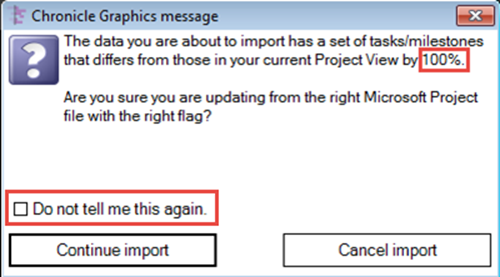Merging the Wrong Tasks into a Project View - OnePagre Express
Merging the Wrong Tasks into a Project View – OnePager Express (7.7)
As we explained, OnePager Express can consistently create snapshots from period to period with updated information from a project’s Microsoft Excel plan. The tasks that are presented to OnePager Express in “UPDATE” mode should be the same set of tasks with, perhaps, some added or removed as the project moves toward completion.
Sometimes you may make the mistake of accidentally updating a project view with tasks from the wrong Microsoft Excel spreadsheet. Or with the wrong set of tasks from the right Microsoft Excel plan if the user is making several project views from the same Microsoft Excel plan.This causes the project view to suddenly appear “messed up” because it now displays many new tasks that reside in many new rows and swimlanes. Even the earlier snapshots are affected by these new rows and swimlanes. When this happens, the best idea is to immediately press the “Undo” button above the OnePager ribbon. This action will immediately restore the project view to how it was before all the unfamiliar tasks were merged into it. Or you can simply close the messed-up project view without saving it. When you reopen it, the erroneous update will be gone.
To avoid this problem in the first place, you may prefer to be warned before the wrong tasks are imported into the project view. This warning process is described below:
OnePager Express examines the tasks that are imported each time an update is underway and provides a warning message if there are forty percent (40%) or more new tasks or forty percent (40%) or more missing tasks when compared with previous snapshots. Under these circumstances the Chronicle Graphics Message shown below will appear.

When the warning message appears, selecting the “Continue import” button will signal OnePager Express to continue and merge the tasks into the project view as you have directed. This will result in new rows and swimlanes for new tasks and may result in blank rows and swimlanes for missing tasks. Note, however, that checking the box titled “Crop newly empty rows on import” on the “Advanced” tab page of the “Project-View Properties” or “Template Properties” forms will ensure that the blank rows are automatically hidden. Selecting the “Cancel import” button will stop the import process at this stage to allow you to examine the Microsoft Excel plan and the selection-flag settings before proceeding.
Sometime you may fully intend to add or delete a large number of tasks to a project view in “UPDATE” mode, so this warning message can be suppressed by checking the “Do not tell me this again” check box. If you change your mind about suppressing this message, there is a checkbox in the “Project-View Properties” form on the “Advanced” tab that can be checked to re-enable the warning. Similarly, the “Template Properties” form at the “Advanced” tab has the same checkbox option.